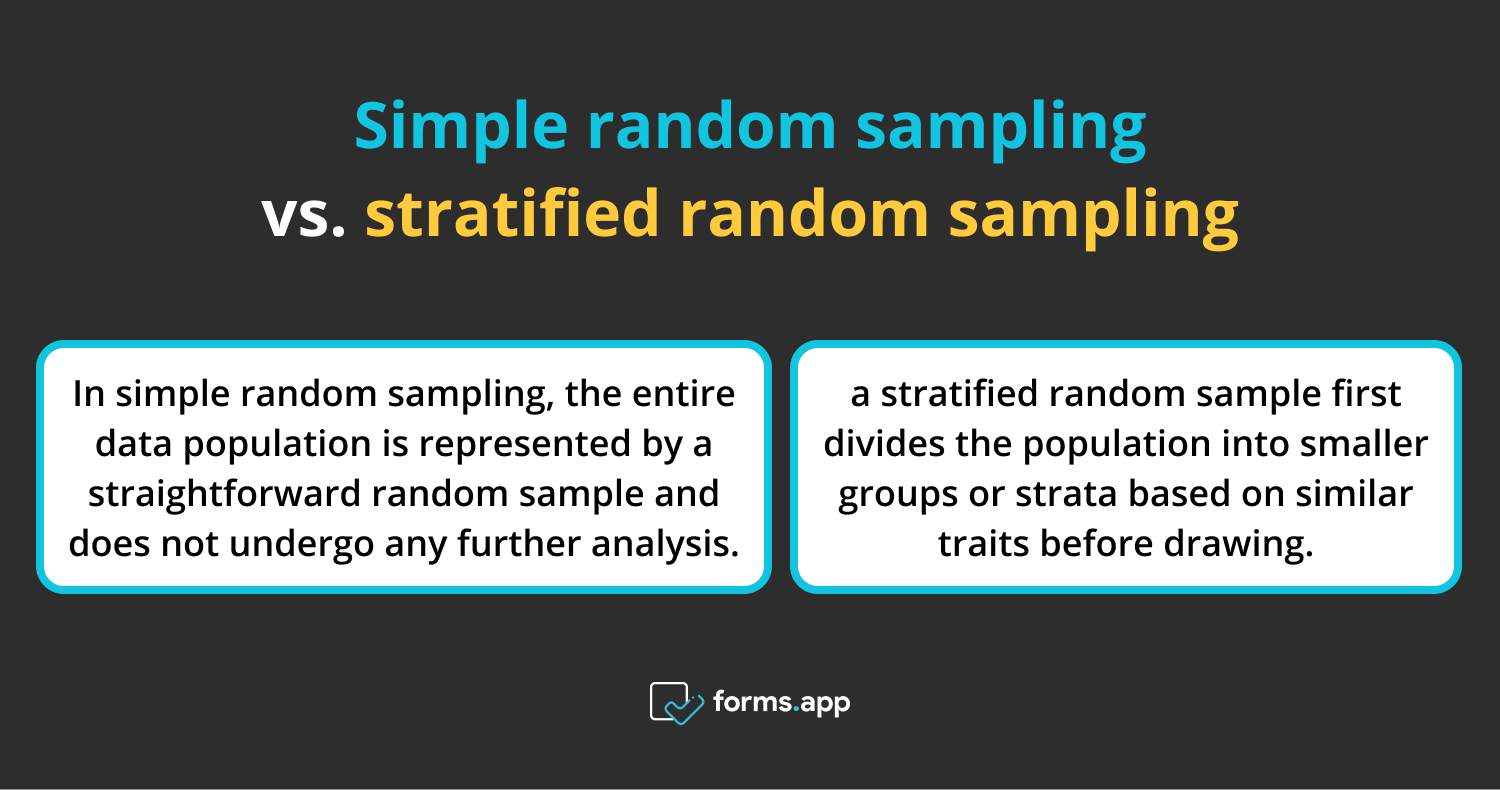Today, the sampling method is used in various branches and many types of research. Sampling is what people use to decide with the help of their logic. Stratified random sampling is popular among sampling types. Researchers often use this method in their studies.
Stratified, where a simple random sampling method is applied to each stratum sampling, is called stratified random sampling. This article will explain the definition of stratified random sampling, the types of stratified random sampling, and its advantages and disadvantages.
What is stratified random sampling?
Stratified random sampling is taking a sample from the strata using the simple random sampling method. This tool is used when the units in the mass have a heterogeneous structure. With stratified random sampling, conclusions about the population can be drawn. The layer can be inferred in different ways.
Stratification ensures that every stratum is represented in the sample and draws conclusions about particular population subgroups. Population stratification allows researchers to ensure that their sample represents the entire community and is free from biases associated with sampling. Unlike a purposive sampling method, the samples are randomly selected in the stratified random sampling method.

The definition of stratified random sampling
Types of stratified random sampling
Each subgroup of a given population is adequately represented across the entire sample population in a research study thanks to stratified random sampling. There are two different types of stratified sampling methods. Stratification can be proportional or disproportionate.
Proportional Sampling
In a proportionate stratified sampling method, each stratum's sample size is inversely correlated with its population size. Because it more accurately reflects the general population, this kind of stratified random sampling frequently results in a more accurate measurement.
As a stratified random sampling example, if the researcher wanted a sample of 500 graduates using the age range, the proportional stratified random sample would be obtained using the formula: (sample size/population size) × strata size.

Proportionate stratified random sampling formula
Disproportionate Sampling
The size of each stratum in a disproportionally stratified sample is not equal to the size of that stratum in the population. The accuracy with which the researcher assigns fractions will determine how well the sampling technique works. The results could be skewed by over or underrepresented strata if the subsets allotted are not precise.
How to conduct stratified random sampling
The subgroups in your population that you are interested in will determine the strata. These subgroups are based on participant characteristics such as gender, race, educational level, location, or age group that differ from one another. You can do stratified random sampling by following the steps below.
1 - Identify the layer required for your sample
Stratified is usually created based on the differences between the typical characteristics of the participants, such as race, gender, nationality, education level, or age group. Researchers may or may not have prior knowledge of the common characteristics of a population.
2 - Define your sample size
It is crucial to specify your sample's ratio numbers to represent the entire population accurately. Use an already existing sample size or define a sample size that contains all the information of the stratification variable for all items in the target audience.
3 - Make a random selection from each stratum
Random sampling techniques are used to choose participants randomly from each stratum after dividing each member of the population into relevant subsections. Simple random sampling or systematic random sampling are two potential sampling techniques for random selection.
4 - Examine the stratum results
There must be a stratum to which each member of the population belongs. When done correctly, stratified random sampling yields a final sample that is complete and mutually exclusive.
5 - Combine all stratum instances into one representative instance
You should combine all tier samples into one sample to obtain a precise, representative sample of the entire population. You will then be able to conduct a complete population analysis. You can obtain a precise stratified random sample by using the before-mentioned steps.
Advantages of stratified random sampling
Stratified random sampling is helpful when a population is heterogeneous, and a simple random sample may not produce reliable results. The technique of stratified random sampling has several benefits over other approaches. Some of its main advantages are:
- This sampling technique results in characteristics in the sample representative of the general population.
- In populations with various traits, stratified random sampling is practical, but it is useless without the ability to create subgroups.
- Stratified random sampling captures key population characteristics in the sample.
Disadvantages of stratified random sampling
Every study cannot be able to use this research methodology. The method's drawback is that it can only be applied correctly in certain circumstances. Each individual in a population under study must be identified and assigned to one and only one subpopulation.
- If a subject is divided into more than one subgroup, overlap may be an issue.
- When researchers are unable to divide the population into subgroups, stratified random sampling accurately suffers.
- Additionally, it can be challenging to locate a complete and accurate list of the entire population.
Use cases of stratified random sampling
When a researcher is interested in differences between groups based on factors such as race, gender, age, or educational attainment, they may use stratified random sampling to learn more about various subgroups or strata within the population under study.
- Samples with a hard-to-reach or hard-to-contact population can be easily included in the research process using the cascade random sampling technique
- In surveys, opinion polls that consider demographics such as age and population by region often use stratified random sampling.
- Researchers use this sampling method to establish a relationship between two or more layers.
- When a researcher wants to narrow their focus to a select group of strata using the population data that is currently available, stratified random sampling is a very effective sampling technique. Thus, the research sample contains the desired characteristics of the layers.
Simple random sampling vs. stratified random sampling
Simple random sampling and stratified random samples are popular methods for obtaining a sample and are frequently referenced by researchers. In simple random sampling, the entire data population is represented by a straightforward random sample drawn randomly and does not undergo any further analysis.
On the other hand, a stratified random sample first divides the population into smaller groups or strata based on similar traits before the random drawing. Therefore a stratified random sampling strategy will ensure that individuals from each subgroup are included in the data analysis. For larger and more complicated sample groups, it is a helpful method.

Comparison of simple random sampling and stratified random sampling
Conclusion
In conclusion, stratified random sampling is a valuable probability sampling technique in which the total population is divided into homogeneous groups to complete the sampling process. Stratified random sampling is crucial to researchers because it improves the reliability and validity of the findings.
Researchers frequently employ stratified random sampling to assess data from various strata or subgroups. It enables them to swiftly and conveniently gather a sample population that most accurately mirrors the studied population.
forms.app, your free form builder
- Unlimited views
- Unlimited questions
- Unlimited notifications



